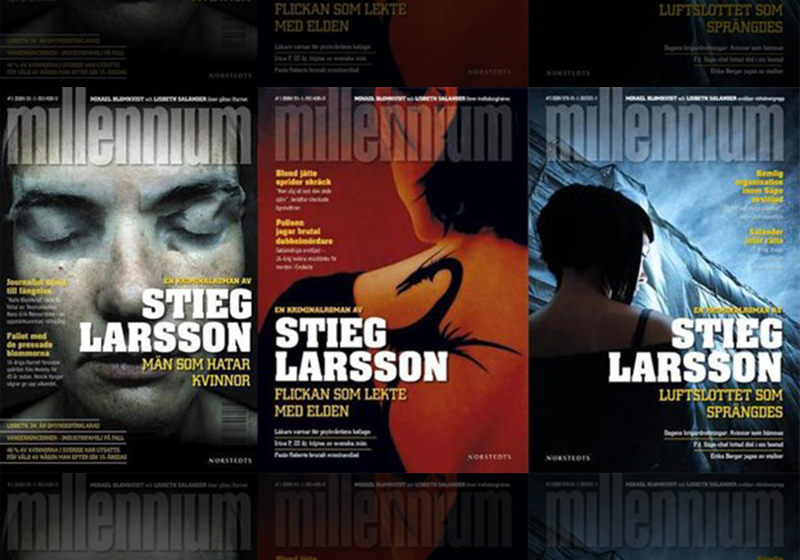Table of Contents
The new millennium had only just started when the world was first introduced to the crime saga that would redefine the literary genre, and to its author, Stieg Larsson.
The Swedish journalist and author – who died of a heart attack in 2004 – did not get to see any of his books published while he was alive. One thing is certain, however: his Millennium series of books is destined to remain one of the most successful literary phenomena of all time.
His books have already broken numerous records. By 2015, ten years after it was first released, the saga had sold 80 million copies worldwide, and in 2010 Larsson became the first author to pass one million sales on Kindle.
Today, however, we’d like to look at this success story from our usual perspective: the covers. Here are the various graphic designs that have accompanied the Millennium trilogy – edition after edition and across the world.
The magazine-style covers of the Swedish first editions of the Millennium trilogy.
The story of Stieg Larsson and the Millennium series is one of a cruel twist of fate. The author started writing the trilogy – which he planned to follow with another seven books, to make a total of ten – in the summer of 2002, when, as his partner explained, he was feeling particularly bored. But shortly after embarking on the project, on 9 November 2004, he died at his office in Stockholm, where he worked as a journalist.
A few months before then, the Swedish publisher Norstedts Förlag – one of the biggest and oldest in the country – had agreed to publish the author’s first three novels. They ended up being released posthumously.

The Swedish cover of Stieg Larsson’s first novel, The Girl with the Dragon Tattoo, depicts the magazine Millenium: the publication that provides the focal point for the investigations described in the novels, and which over the years became the most common name used to describe Stieg Larsson’s saga.
The same graphics were adopted for the other two novels in the trilogy: The Girl Who Played with Fire and The Girl Who Kicked the Hornets’ Nest, published in 2006 and 2007 respectively.

But if you look closely at the covers, you’ll notice something odd about the size of the lettering. The author’s name is bigger than the book’s title: a rather rare occurrence, which usually only happens when the author is very well known.
Indeed, Stieg Larsson was not a completely unknown figure in Sweden. Although he hadn’t published any books or achieved the popularity he would get after his death, Larsson was nevertheless a respected journalist whose name was linked to activism and research into the far right.
The first foreign edition: the Millennium series’ French covers
France was the first nation to see the potential of the Millennium saga and Stieg Larsson’s writing outside his native country. The publisher Actes Sud bought the rights to it and released the detective trilogy in record time.
If you look at the covers used for the 2015 edition, you’ll see they use numbers to emphasise the trilogy concept.

The covers of the English versions of Stieg Larsson’s Millennium trilogy (and a rejection letter)
Meanwhile, in the English-speaking world, there was no mention of it being a trilogy, at least on the covers. Here are the first UK and US editions, which came out in 2008, when the Millennium series was already a global literary phenomenon.


There was also a rare 2010 box set edition published by MacLehose, which came with a rejection letter received by Stieg Larsson. In 1972, he had tried to attend journalism college in Stockholm, but failed the writing entrance exam.
Proof that tests don’t always select the best candidates, given his subsequent success as a journalist and writer!
Other covers of the Millennium series from around the world
In any case, as we said above, it only took a few years from their 2005 release for the three Millennium novels to become a global literary sensation. The initial translations into French and English were followed by editions all over the world, released at an incredible pace, showing what the global publishing industry is capable of in the new millennium!
Here is a round-up of the covers of some of the international editions that came out in the late 2000s and 2010s. As well as the range of sophisticated design choices, it is also worth noting the diverse range of translations of the titles. Some foreign editions stuck closely to the original Swedish titles, like the Italian and Brazilian editions, while others took them in very different directions. In Germany, for instance, the titles of the Millennium trilogy are each a single word, while in Spain and France the title of the second volume is somewhat different from the original. Likewise, the title of the first book in English, The Girl with the Dragon Tattoo, is nothing like the other translations of the same title.
Anyway, enough waffling, let’s look at the covers!
In Spain, Stieg Larsson is published by Destino. Here are the Spanish covers of the Millennium trilogy.

The Brazilian edition, published by the oldest publishing house in São Paulo, Companhia das Letras.

The dark covers of the Czech edition of the Millennium series.

The covers of the Italian edition published by Marsilio in 2007. You can see the legacy of the traditional design of Italian thrillers.

The covers of the Korean edition, released in 2011.

The unusual covers of the German edition, also noteworthy for their titles, which differ completely from the Swedish original.

The covers of the Dutch edition of Stieg Larsson’s Millennium series, which together create the dragon tattoo, reinforcing the trilogy concept.

How about you? Do you know of any other special editions or surprising covers from Stieg Larsson’s Millennium saga?

